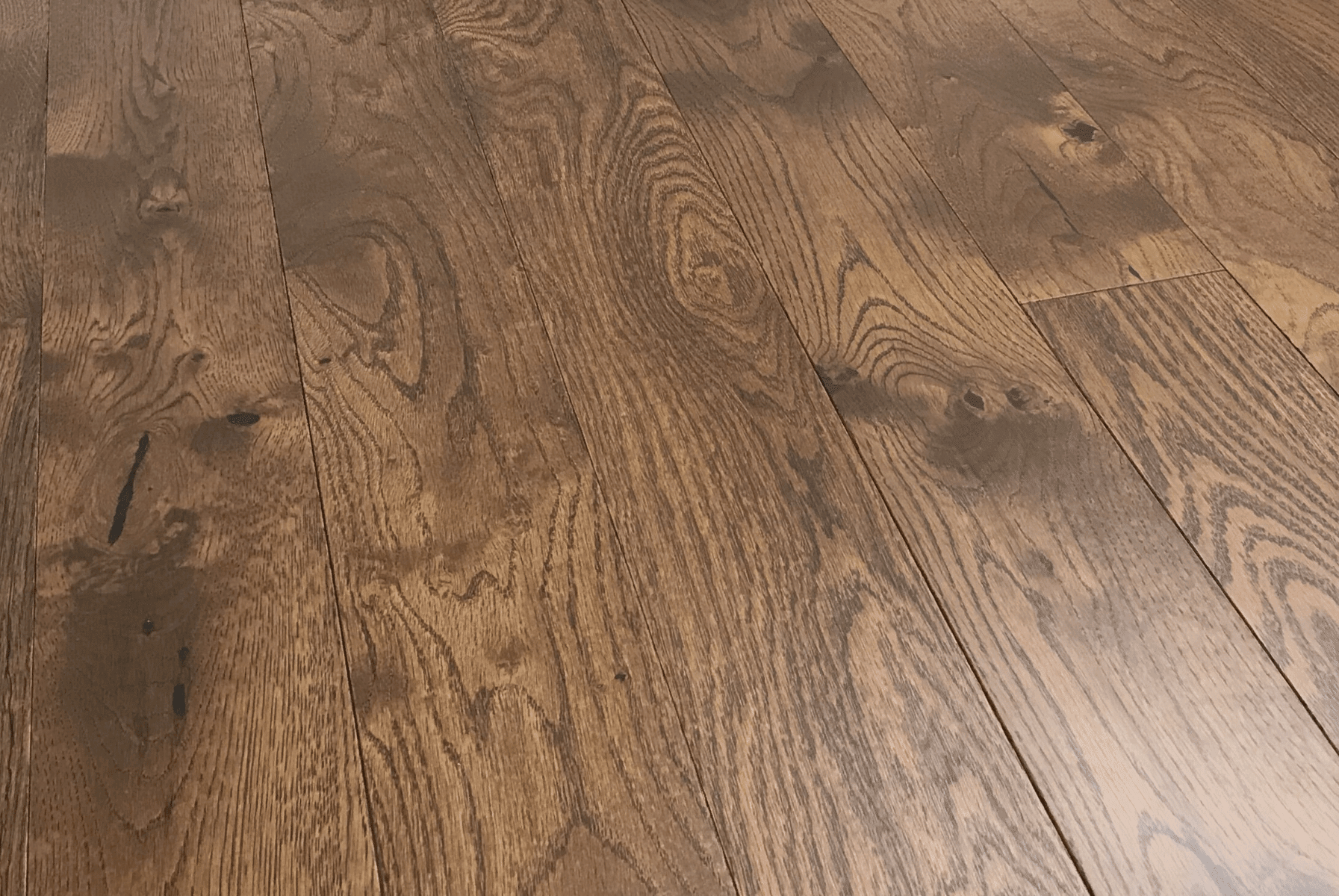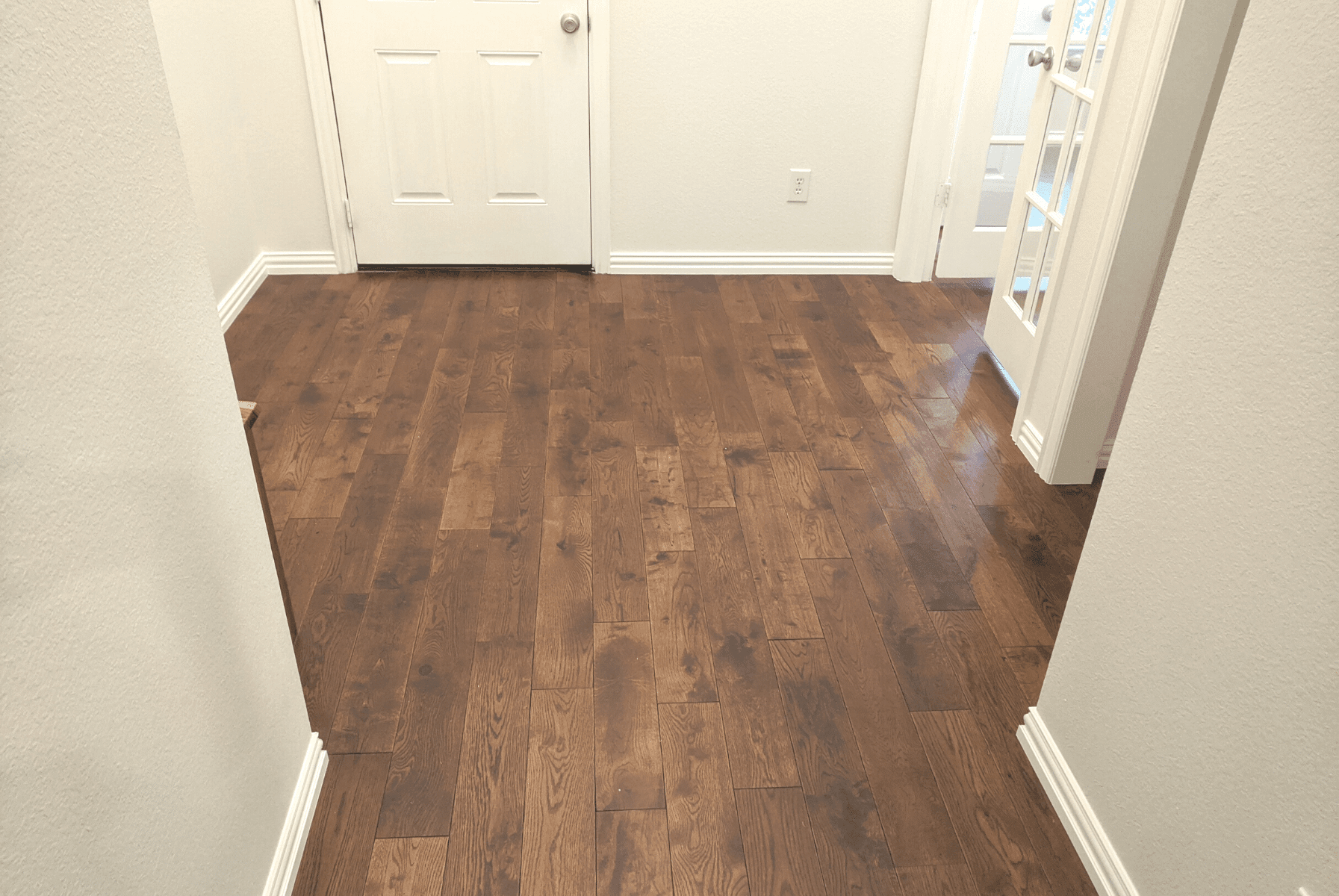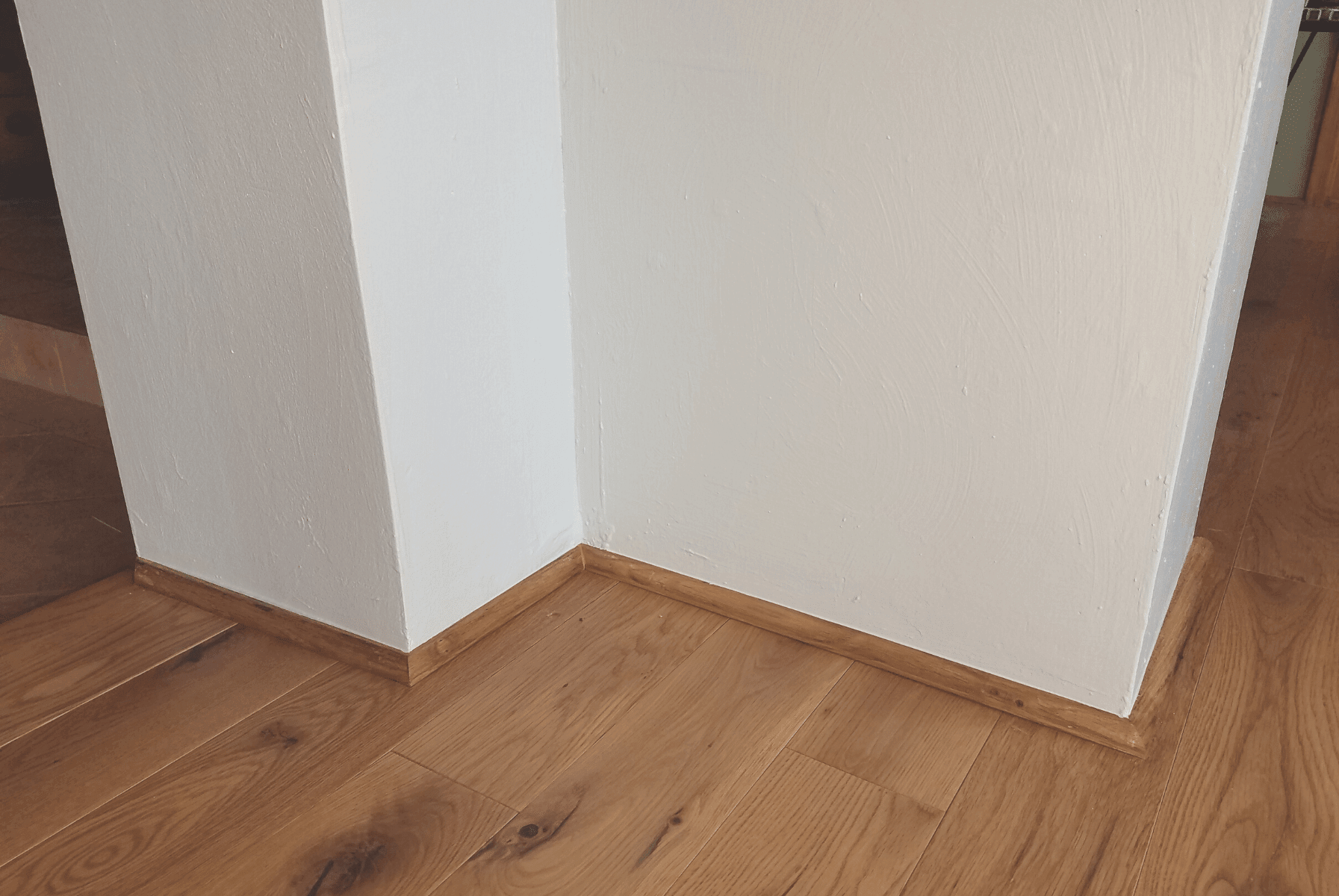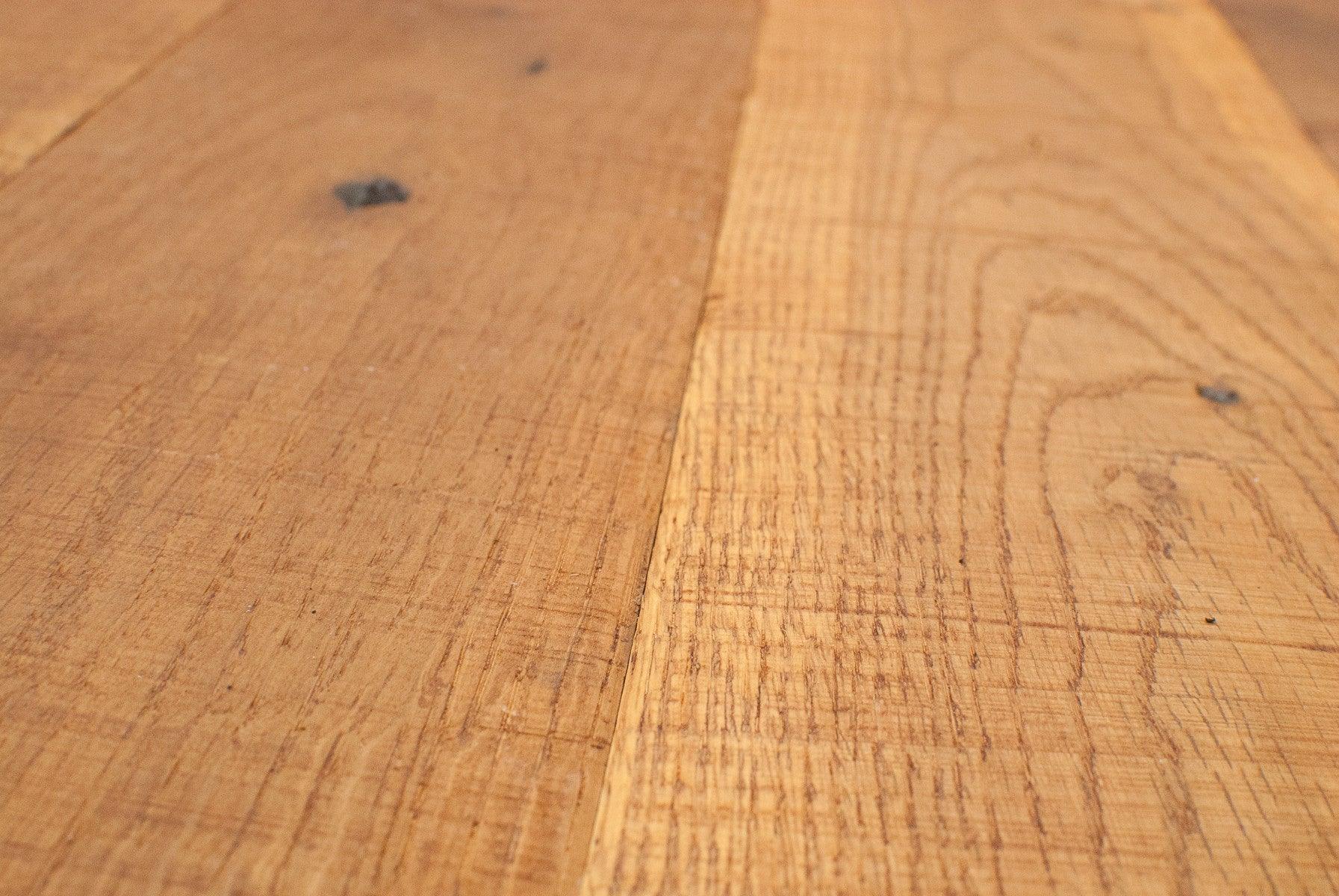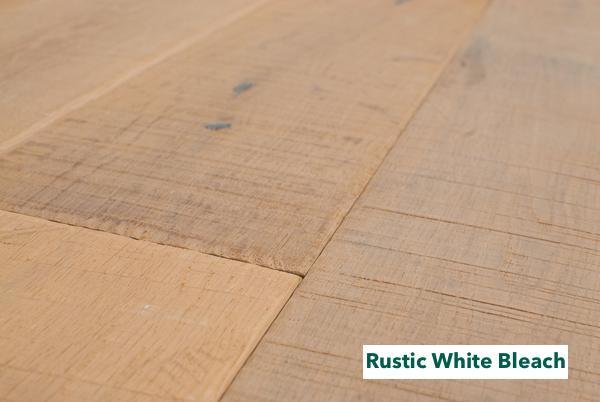Wood flooring does more than support your furniture; it defines how a home feels. From the golden glow of oak to the grounding richness of walnut, hardwood brings timeless warmth to any space. But choosing the right floor isn’t just about style; it’s about where it lives. The best hardwood flooring for every room depends on light, traffic, moisture, and mood.
This guide explores how to match species, finish, and colour to each space, creating a home that feels cohesive, durable, and beautifully designed from the ground up.
Where Wood Belongs: Ideal Rooms for Hardwood Flooring for Every Room
Every floor has a purpose and not every room plays by the same rules.
Floors in our home take a lot of abuse, especially the kitchen, rec room and living room. You need to consider how your family uses each room before deciding about the right flooring options.
Choosing the right hardwood floor in certain rooms will set the stage for your interior design choices. Wood flooring adds years of amazing beauty, durability, and comfort to any home.
Here are our recommendations and ideas to transform your interior spaces.
Living Room
The Heart of the Home Deserves Natural Warmth

A National Association of Home Builders survey listed “hardwood on the main level of the home” as “essential.” The living room is usually the most walked-through, and the biggest floor of any home, especially if it connects directly with the dining room or kitchen as an open concept plan.
It’s also where you’ll see the greatest impact of choosing the right hardwood flooring for every room, since the living room often sets the tone for the rest of the home. You don’t need much maintenance, and usually, it comes with a guarantee of up to 25 years.
Home Office or Den
A Quiet Foundation for Focus and Creativity
Whether you need the solitude of a home office or you plan on seeing clients, hardwood adds a professional look to your space. It’s practical, easy to clean, inspiring and original.
Lighter flooring works best if the room has small windows or is in the shade most of the day.
Dining Room
Durable Elegance for Life’s Celebrations

Whether it’s a birthday, Thanksgiving, Christmas or anniversary, the dining room is always where people meet and eat. It’s also the area where the most spills of food, wine, and juice happen. Dining room furniture can be tough on floors too with chairs and table legs moving all the time. One of the best flooring ideas is oak for this room because it can withstand the abuse.
Oak has the combination of affordability, durability, and elegance. Choose a wider board, 5 to 7 inches if available. Lighter stains or neutral will contrast nicely with modern furniture as well as dark stained antique heirlooms.
Bedroom
Barefoot Mornings Deserve Soft Grain

We tend to have bare feet most of the time in the bedroom. If you’re not going with carpet, choose a wood floor that has a smooth finish, either high-gloss or satin.
White oak is a common wood floor choice for bedrooms. It takes stains well and also looks great in a natural finish. It doesn’t hold dust and shed fibers like carpet. It cleans easily with a dry dust mop, and you’ll breathe easier at night.
Kitchen
A Classic Choice with a Modern Edge

The kitchen is a focal point for most homes and must endure lots of foot traffic. Hardwood floors in the kitchen must withstand the occasional dropped dish, fork, knife, or frying pan. Tile and wood are two of the most common flooring options. Tile is impervious to liquid spills, but it can chip if something heavy falls on it.
White oak flooring is one desirable kitchen flooring option. Oak stands up to traffic and works in small or designer chef kitchens. Go with a light, rustic texture to help hide dings and scratches longer.
Hardwood floors in the kitchen will require more maintenance to keep it clean and to remove stains. Be sure your floor has multiple layers of sealer to protect the finish from spills.
Basement
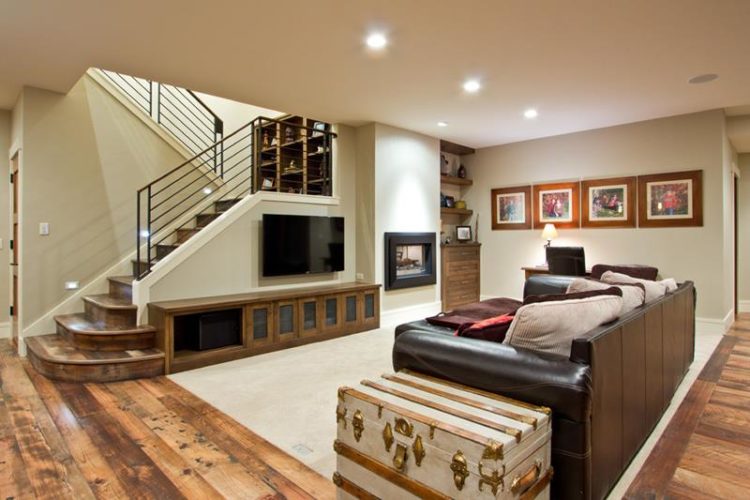
It’s not always advisable to put a wood floor in a finished basement area (below grade) unless there is no ground moisture seeping up through the slab and the humidity is between 50% and 60%. Even vinyl or tile floors can have problems with moisture wicking up through the slab if it’s not sealed correctly.
Wood makes a basement more comfortable, quieter and warmer. You can use wood in a basement provided it’s a floating floor on top of a watertight moisture barrier.
Here’s more information on how to install a solid wood floor in the basement. Choose the lightest stain or natural wood to brighten the entire area.
Rec Room
From Playroom to Movie Nights, a Floor that Evolves with You

Rec rooms see a lot of action, especially with kids, pets, and toys. Chances are, it will see many different uses over the years. From kid’s parties to a movie theater and eventually the future man cave, the rec room is another space that deserves a floor that’s not only durable but fashionable.
One wood flooring idea is to use a natural or light stain with a satin or matte finish to hide any scratches. The rustic texture would be the best choice to handle the traffic.
Powder Room
Style Meets Continuity — With Caution

Although small, half baths should match the elegance of the living space décor.
Powder rooms, or half-baths, are typically small rooms close to the main living area for guest use. It makes sense to tie the floor in with the surrounding floor outside the door, be it a hall, living room or kitchen.
When Wood Doesn’t Work: Rooms to Rethink
Just because hardwood looks good doesn’t mean that you should have them in every room. Here are the rooms you should avoid and why:
- Bathroom or Washroom with a Tub or Shower – Water and harsh chlorine cleaners can damage the finish of any wood flooring.
- Mudrooms – Water, sandy mud, and salty winter slush can scratch and leave permanent stains.
- Saunas – Excessive heat and humidity. Great for skin, bad for high-quality wood.
- Exterior spaces like porches – Excess direct sunlight can fade the finish. Extreme swings in temperature and humidity can cause buckling, cupping, cracking and warping.

(A wood floor buckling from extreme moisture beneath)
Note: If you install wood floors that become wet and begin to warp or cup, use a dehumidifier or fan to dry the boards. As they dry, they should straighten out and lay flat again in a few days, provided there is no constant moisture remaining underneath the floor.
If you're worried about humidity levels in your air, one great option is a central dehumidifier system for your home. Here are a couple great options.
Designing from the Ground Up: How to Choose Floor Colour
Whether you plan on sanding and refinishing an existing floor or laying down a new one, color is an important decision. The floor color is the foundation of the room’s design. It sets the tone for wall colors, furniture, accent pieces, and even artwork. Here are some interior designer tips to help you choose the right color for your wood floor.
Light or Natural Wood

Light, honey-colored stains or natural oak with a clear finish lighten any space. It reflects natural light, adding a feeling of openness.
Wall colors that work well with natural oak or light stains are off-whites, light grays, and pastels. An added benefit of a light-colored wood floor is it doesn’t show dirt. Hardwood has undertones of color. These are the deeper colors in some of the wood grain. You can use these undertone colors to match wall or trim paint to unify the room.
Dark Stains, Cherry and Walnut

Both cherry and walnut have beautiful rich tones and unique grains and features. However, you can have too much of a good thing. That’s why you see these beautiful woods as cabinets and tables. An entire living room of walnut or walnut-stained wood will be dark, day and night.
When installing a large room with a dark floor, it is important to keep in mind that it will absorb a lot of light. You’ll need big windows, substantial lighting, light-colored furniture, and wall colors to add contrast and light. Darker floors tend to make a room look smaller, yet cozy and intimate. With a dark floor, your wall colors can go from cream to deeper primary colors.
Bleached or Gray-Stained White Oak

If you want to paint the walls charcoal or pastel with stronger colors, then bleached or grey oak floors will make those wall colors pop.
Bleached or grey-stained white oak covers the yellow tones of the wood while retaining the interesting character of the wood grain. Either flooring choice will create an elegant look. The neutral color of the floor allows for endless design and color possibilities for walls, trim, floors, and accent pieces.
Need some color advice? Here are
The Art of Colours: Which One is Right for You?
- Choose an architectural or design element of each room and match the flooring color to it. For example, a stone fireplace in the living room, large ceiling beams, the color of the kitchen cabinets, or the paint color in the bedrooms.
- Use lighter colors in smaller spaces where you want to create a lighter, more open feel.
- Darker floors work best where natural light is abundant in the room. They provide contrast to light walls and furniture.
- Use your furniture to help choose a contrasting shade.
- If you have light walls, kitchen cabinets or light stone fireplace, go for a darker floor. Keep in mind that the darkest and the lightest floors tend to show dirt and dust more readily.
- Light floors unify light walls and make the room look larger, casual and fresh.
As we stated earlier, color is a personal preference. If you desire a specific color, you may have to opt for a custom job where they will have to finish the floor on-site. That means a big mess and delays.
For DIYers who want the elegant look of wood without the difficulty of finishing onsite, choose a pre-finished hardwood floor. Most pre-finished floors come in neutral, gray, and dark which will fit just about any décor. You’ll save time, money, and headaches
Order samples to bring home and place next to large architectural or furniture pieces to visualize the finished floor.
Before You Buy: Five Things to Consider
Before you settle on a certain hardwood floor, there are some things to consider. Hardwood is not suitable for all flooring applications. These are things you need to know before selecting. Taking time to match the right wood species, texture, and finish ensures your investment in hardwood flooring for every room pays off in comfort, durability, and design harmony.
1) Type of Wood and Traffic
Each species of wood has a unique color, grain pattern, and hardness. The Janka Scale measures the wood’s density and hardness. Harder wood withstands dents and nicks. For example, hard maple, used in cutting boards and expensive flooring, has a Janka rating of 1,450.
By comparison, the two most common hardwoods for flooring are Red Oak, at 1,290 and European White Oak at 1,360. Some fruit woods like black walnut or cherry, while dark and beautiful, are not as durable as oak and therefore, not the best choice for wood flooring.
High traffic areas require a hardwood like oak to withstand the test of time. It’s tight grained and medium priced. Oak accepts a variety of stains from neutral to coffee, and the open grains add texture to any space.
2) Board Size – Wide or Narrow?
Flooring board widths range from 2 ¼ in. to more than 7 inches on some custom flooring. Narrow boards like 2¼- to 3½-inch work well in smaller, formal spaces such as a dining or sitting rooms. Wider planks of 5 inches or more are very popular in both contemporary, traditional, or homes with a rustic, country design. 5-inch hardwood floors work well in large areas such as living rooms and open design plans where the kitchen is part of the dining or living area.
We need to mention the thickness of the wood. Look for ¾ inch solid hardwood boards because they will last years longer with less chance of warping or cupping.
Here's what one architect on Houzz had to say:

Spend a little more now on a ¾ inch floor to save significant money and hassle down the road.
3) Texture – Smooth or Rough?
You’ll find two kinds of textures in flooring, smooth and hand-scrapped. A smooth finish has been sanded, stained, and sealed to create a uniform, even sheen across the entire surface of the floor. It’s best for low traffic areas like bedrooms and living rooms where there are rugs in the higher traffic areas.

Rough textures include terms like rustic, hand-scraped or distressed. This texture looks like the boards just came from the sawmill if you prefer a natural look. With a darker stain, they hold up well to heavy traffic and don’t show the dirt and scratches like a smooth finish. A rough texture brings out the natural character and imperfections of the wood to provide a unique look to any space. Hallways, kitchens, and big open areas can benefit from this textured look. If you have pets and kids, a rough finish will stand up better.
4) Finishes – DIY or Pre-finished?
Before you talk about the types of finishes, you need to decide where you’ll finish your floors. Many times, homeowners and DIYers want to have their hardwood floor installed and then use a custom stain on site. It’s very time-consuming, and you wait one to three days between multiple coats for them to dry. It’s easy to ruin the floors if you don’t have the experience and tools to finish a wood floor properly.
The best option is to purchase prefinished hardwood flooring. You avoid the mess and fumes of doing it in-house. With prefinished hardwood flooring, you can walk on it as soon as it is secure. No waiting days for each coat to dry. Plus, the factory has better control over the color for better uniformity. Many times, DIYers who try staining and sealing a floor at home can’t finish the job on the same day. The second half of the floor ends up a shade lighter or darker than the first.
There are two parts to finishing a wood floor, the stain or color, and the final preservative coat. A stain adds color, and the final finish protects the stain and wood from dirt and wear.
Stains can come in a rainbow of colors. However, natural wood and light stains, or bleached wood provide maximum design flexibility. They add light and openness to even small rooms.
Typically, the final coat is a tough polyurethane that protects the stain and wood from foot traffic and wear. They are either satin or high-gloss depending on the look you want. Satin gives a soft, warm glow that highlights the wood grain. High-gloss reflects more light and shines.
5) Maintenance
Hardwood floors require little maintenance. Sweeping and vacuuming regularly will remove dirt and sand that can scratch the finish. Damp mop occasionally but do not leave standing water or use any soap or chemicals as it can discolor the finish. If you really want to maintain your floors easily, consider a robot vacuum that can keep your floors dirt-free and squeaky clean with no work from you at all!
Should an accident occur and leave a mark or gouge, it is easy to fill, color and finish. You can refer to this article on how to repair a hardwood floor.
The final finish or top coat affects the maintenance. A solid wood that has a hand-scraped, rustic look will also have a matte finish. It is easier to maintain because you won’t notice small scratches that happen over time.
3 Ways to Install Hardwood Floors
Now that you are ready to purchase your hardwood floors, there is one more piece of the puzzle to consider, and that’s the installation. Different manufacturers require different methods.
1) Glue or Industrial Adhesive
Gluing your floors to the subfloor is a common practice, and It requires less skill than nailing. The most significant drawback is the mess. There is a high probability of getting glue on the finished wood. Leaving the glue on or trying to remove it with a solvent can ruin the finish and spots can stick out like a sore thumb.
Gluing is a permanent solution and will not allow the boards to move during periods of humidity and temperature changes. This immobility can result in cracking, warping, or cupping.
2) Nailing or Stapling
Using a fastener like nails is also a permanent and immobile solution. Many floor contractors like using nail guns because it speeds up the process of laying the floor. DIYers without practice can injure themselves and damage the floor using a nail gun.
3) Reusable Clips
Currently, Easiklip is the only solid hardwood floor manufacturer that uses a reusable aluminum clip to hold the boards together. The finished floor “floats” or lays on top of the subfloor. By not permanently attaching to the subfloor, the boards can expand and contract naturally due to variations in the weather and conditions in the home.
Should it be necessary, one board or the entire floor can be removed, repaired, or reinstalled anywhere. There are no glue or nails required.
The Easiest DIY Hardwood Floor Solutions
European White Oak is one of the best choices for prefinished hardwood flooring because it is hard, durable, and brings an elegant warmth to any room. Easiklip flooring is ¾ inch solid, sustainable European white oak flooring that comes in four styles:
- Natural Oak – A classic look with a modern feel. Natural oak brings an inviting warmth to any room.
- Greywash – Perfect for a sophisticated modern look or a casual beach house feel.
- Rustic Smoke Stain – Gives the appearance of hand-sawn boards for a reclaimed look or country vibe.
- Rustic White Bleach – The lightest floor in Easiklip’s lineup. It goes well with large or small rooms, dark furniture, cabinets, or accent pieces.
The rustic finishes work well in high traffic areas such as kitchens, hallways, recreation rooms, and basements.
To make a statement in the rest of the house, either the Natural Oak or the Greywash will match any décor. The smooth texture feels luxurious and warm under your bare feet.
The most significant advantage of an Easiklip floor is the ease of installation. The boards clip together securely with our patented aluminum clips. There is no glue, screws, nails, muss, or fuss. It’s the perfect solution for DIYers. Here’s a quick video to see how easy it is to install Easiklip flooring.
It is a floating floor that installs over any smooth sub-floor and can be used over radiant heat or in some basement applications. Every box comes with a 30-day money back guarantee and a 25-year warranty.
Hardwood Flooring for Every Room
Hardwood flooring isn’t just a design choice—it’s the foundation of how each room feels and functions. From the elegance of white oak in the dining room to the quiet warmth of natural oak in the bedroom, the best hardwood flooring for every room balances beauty, comfort, and practicality. With Easiklip’s clip-together solid oak system, you can install luxury hardwood in hours—no glue, no nails, no mess.
Before you purchase any flooring, test it first by ordering a sample pack. Easiklip will send you a 5 in. x 5 ¾ in. sample of each of the four-floor types plus two patented aluminum clips to show you how it works. Order your free sample pack today to visualize the design possibilities in your home.




